### Amsterdam, late summer of 1997. Pink posters appear around the city, pasted in grids. They feature a bitmapped image of a young girl, set into a floating browser window, a large computer mouse hovering over it:


Mouchette does not attend the festival. In her place, a man named René Paul Vallentgoed appears. Vallentgoed works as an agent representing poets who can be booked for live readings. He tells the audience that Mouchette, who has published poetry in magazines and on an audio CD, could not attend the festival, being so young, but that they can ask him questions. Vallentgoed has a deep voice and a conspicuous style.
This is a photo of Vallentgoed:

A visit to the web page listed on the flyer yields little additional information about Mouchette. Instead, it has questions of its own.
Have you seen my posters hanging everywhere in the city of Amsterdam? What was I doing there? Did you meet me? Do you remember? Can you tell me what I did?
Nearly twenty years later, visitors to the page, now hosted on Mouchette.org, continue to share their experiences of encounters that never happened. ###
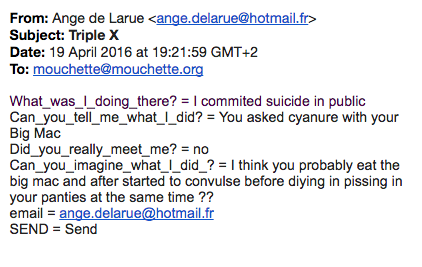
One of the web’s most enduring personae, Mouchette has maintained a constantly expanding online presence since 1996.
She tells visitors to her site that she is nearly thirteen (eternally so), that she lives in Amsterdam with her parents, that she is an artist and a poet. They see her image in a small thumbnail, or distorted scans of her tongue or cheek. Her presence is promised and palpable, but never quite manifests. She’s elusive.
Flies, bloodcurdling screams, suicide, and death: Mouchette is interested in the same things that many young girls are. And like all young girls with web pages, she is subject to many people’s ideas about what she should or should not do or say. Because of her fame, adults worry that she is a poor role model.
Mouchette has many fans. Sometimes, her fans share strange desires or violent impulses; more often, they reach out seeking a connection. Her fans create art in tribute to her, and they send these works to her as gifts.
They can even become her, using mouchette.net, an identity-sharing interface. The images and texts they share on mouchette.net occasionally make their way back to Mouchette’s home page. On any given reload, her profile pic might be replaced by a user-submitted image and bio. They can also use this interface to send email as Mouchette.
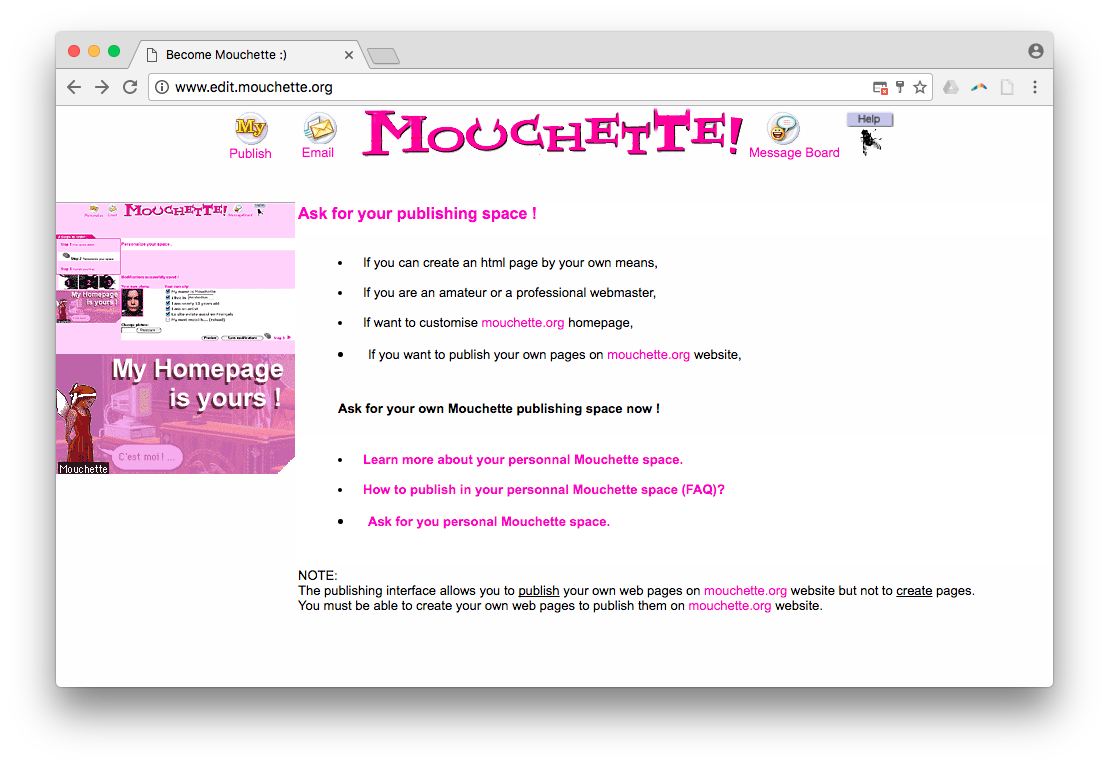
Mouchette is curious about these kinds of responses. She encounters her fans through a screen, the point of connection that also divides, and she is always ready to listen.
Mouchette is a fictional character and a carefully organized absence. She is a kind of projection surface, defined by the changing structure and culture of the web, defined by the users who visit, and return, and contribute to the site. Mouchette is a slowly expanding archive, hosting the stories and fears and desires and reprobation of numerous visitors, carrying traces of their visits and the changing nature of the web itself.
### New York, autumn 2016. I speak three times with artist Martine Neddam, who came forward as author of the Mouchette project in 2010 I type furiously the whole while. When I listen to the recordings I realize that only my voice can be heard, and I must piece the interview together from my live transcription and faint snatches of her voice. Perhaps it is Mouchette's latest act of self-effacement. ###
Neddam: The web character is not so much a portrait as a platform with a certain design... to find a situation where people exchange with each other inside that character. People feed information into it, and that information is published in an exchange.
The anonymity was really important—it created so much intensity, it created really that projection surface for people because they didn’t know who the author was. If you assume it was made by a man, it might be made by a pervert. If made by a woman, it might be made by a feminist. It created a very important sort of appeal, not only an appeal to know who it is, but also a sort of projection surface for your imagination. It was really important in the way people interacted with Mouchette. They had to imagine everything behind, and the intention of the maker, in how they would interact with her.
It takes a lot of energy to hide. As soon as you make this decision to remain anonymous, everything becomes much more complicated. Even communicating with institutions, you have to explain to twenty people why you do that, and that they have to trust you, and trust that this is an artistic project, because it’s a sort of... anonymity is suspicious in itself.
### New York, April 2003. News circulates that the identity of Mouchette, long kept secret, would be revealed at a public event at Postmasters organized by Franklin Furnace. Rhizome’s online series Net Art News publishes a short article asking, “Could You Be the Next Mouchette?” and describing plans for the artist to turn over mouchette.org to a person in attendance at the event. Speculation about Mouchette’s identity on Rhizome’s listserves devolves into name-calling. A French artist, a man, comes forward, claiming to be Mouchette.
In the wake of the event, many people believe that the mystery of Mouchette's identity has finally been solved. ###
Neddam: I'd already had performative events in the presence of Mouchette. Once I had a young girl of that age answering browsing the site and answering an interview on stage, and I was playing the interviewer. But this time there would be a live encounter with the supposed author taking place in Postmasters gallery.
I had a residency grant by Franklin Furnace, during which I created the mouchette.net, which I called the identity sharing interface, where people could become Mouchette. So to promote that interface, I did an event where I was offering the public to take over the website.
Supposedly in that event, the public would come to get the codes to gain control of the site, but they could also meet the site’s author live. A French artist living in New York attended, and also collaborated in creating a sort of crazy inflatable space at the gallery, to sort of ritualize the meeting. I was handy because he was French, so he could better pass himself as me.
One day, I sort of released the anonymity by making an information website. Once the anonymity of the author had been fully inscribed in the history of the character, I could release the control. I had noticed people were searching me less and less, that this intense curiosity was going down. I’d already made so many fake coming outs that a real one wouldn't make sense. It was also a possibility of presenting other works under my name, showing that I had done several internet personae.
### Lambda MOO, early 1990s. A new text-based online community made up of characters and environments developed by its users grows in popularity. People would hang out, chat, and experiment with creating and interacting with spaces and objects, which could be described and even programmed to function interactively.
Users are allowed to choose from a range of genders and can write anything they want to describe their character. They could also describe a space for their character to inhabit, which other users could also visit within the world of the MOO. As LambdaMOO grows in popularity, other MOOs begin to appear, mostly run by universities, hosting their own distinct communities and environments.
Neddam registers for LambdaMOO and creates a persona named Mouchette. In French, a mouche is a fly; Mouchette is also a 1967 film by Robert Bresson about a young girl facing grim adult realities. ###
Neddam: I didn’t remember Bresson’s film very well at the moment I got this girl character. The name was free, you know? Most names I was thinking of were taken. And I remembered this name of a little girl from a film, it was a vision of a little girl character who is not all pink and sweet. It was a very dark film and I like that dark aspect connected to young girls.
[Within the world of a MOO], you would design your space—my space was called AZERTY—you know what that is? It's the French keyboard. It was a text space, a girl made of language and made of text.
You would design your character, but you would also describe your space, and it's like you have a direct connection to your memory, and at the same time you would share it with others: a space of shared imagination.
There were MOOs at universities, one was at MIT. The kind of people you would meet there were super interesting. It had that mixture.
That was really my first love. It was a space for creation and participation at the same time. You could reprogram parts of the MOO itself. That was really the founding experience for me. It took me some time to make something for the web because it didn't have that participatory element. I was really in love with that text space as well, that collaborative text space.
It's not a surprise that I hold on to that participatory element in my art. That's the thing I hold on to even despite all of the difficulty in keeping it working. That's how I fell in love with the internet—you can participate but you can reprogram. You don’t just inhabit that little text field that is given to you. One way or another, I still experience the web with that possibility of re-programming.
### Initially skeptical about the web’s participatory potential, Neddam became increasingly interested in personal home pages. Often derided by web designers and the online public as amateurish, personal home pages gave users a new way to express themselves online.
Neddam: People who had access to write on the web—geeks or people who would make a site for their company—they would show photos of their families and their dogs. So there was a very endearing character to the homepage. I had already played different characters on the MOOs. So that was how I took the idea to design my own character on the web.
### As Mouchette took shape, one of her first projects was to write recombinant nonsense poetry in English, Dutch, and French. “I’m a real text specialist, a poet and a manipulator,” Mouchette boasted. “In one word: a wattlechick.” The poems were published in magazines and on her website, and released as an audio CD with a booklet.
Neddam: In the MOOs I discovered that you could make a bot, and bots were made with Markov chainers. I had an idea of creating jabberwocky words in different languages by using a Markov chainer. But the Markov chainer wouldn't write the whole composition, so it just provided some nonexistent words that I used as raw material. I did the French composition, and then I asked an English writer to write the English version, but i gave them the English language raw material.
It's very difficult to write non-existing words. A bot does it better than you when you fill its database with a very pure sample of the language.
## December 1998, Haarlem, The Netherlands. A Suicide Kit for Christmas is shown in Galerie Tanya Rumpff. The work exemplifies Neddam’s interest in constructing Mouchette not only from software but from her public.
The browser-based work opens with a still image of a girl with angel wings and a Santa hat standing on the bench in a dithered courtroom. She is labeled with the tag “Mouchette,” as if she is an avatar within a videogame world. She delivers a line via speech bubble: “A suicide kit for Christmas?”
On the next page, Mouchette asks the visitor, “What is the best way to kill yourself when you’re 13?” The answers would be sent to Neddam’s inbox.
Neddam: For maybe a year, I would collect the answers by email. They would send a story, I would rewrite them into HTML pages and post them. Even in these HTML pages, I would reply. My sense of the web was that it was an ongoing conversation with the viewer.

Initially, the comments and answers are mostly flippant. [email protected] writes, “rail de coke.” Mouchette’s response: “Un seul?”
Effective search engines are not yet available at the time the work is published, limiting the public that the project might reach to those already in the know—net art audiences and the network that Mouchette developed. Gradually, this begins to shift.
Neddam: Through Mouchette, I would see the web change and expand and modify, and Mouchette would change in response to what was happening.
Suicide Kit was totally a design for the gallery, you could say, with the idea of an artistic public in mind. In 1998, people weren’t using search engines, they were surfing, jumping from site to site, from link to link.
Suddenly the search engines exploded. People were coming en masse and starting to send personal messages, and to respond to it personally. This went into society in ways that I didn’t expect, but it really touched me.
Search engines bring visitors to the site who at times have a pressing need to discuss topics related to suicide. There is a need for Neddam to respond more quickly, and in 1999 she moves to a more automated system of content moderation.
Neddam: When I was receiving these things in my email it was very upsetting, because the messages were so personal it would affect me very much... So that’s where I got the interface where I would classify the entries. A friend made me the dynamic interface—this PHP interface where it would come into a database and I could publish it or not publish it. I wouldn’t react to it any more because maybe it wasn’t the idea.
You will see people seeking help, and people offering help. I would classify the entries, so the ones who wanted to help could reply to the ones who were seeking help somehow, and publishing also all the rest, creating other categories.
It went beyond art. It was not enough to just receive these things and put them back online like a month later and just tell some witty comment next to it. It was something where I had hit on a sort of social fact, and I was involved in it.
Also I think it was very populated because suicide is also an issue with free speech. It's very difficult to talk about suicide in many societies. So I was sort of taken by... not by surprise, but I was overwhelmed by the situation, and that’s how I started to make that database. So I could put things online earlier and let people contact each other.
After a while, I realized that there were some users who came once in awhile to post funny stories, of course with certain dark tones about suicide. It was a stage where I wasn’t even needed. Visitors cared about [consistent contributors such as] Lucy Cortina more than they cared about Mouchette. They carried the story of the web character in their own way. So the construction of the database happened by following what was happening.
I got the database system in 1999, of course it went through a lot of phases, but for many years it played a strange role in my life. And the art world people didn’t really care for it—they didn’t care for the fact that people were using it in very personal ways.
It has been a big part of my life, that moderation. I even went to court because they thought I was hosting suicide recipes.
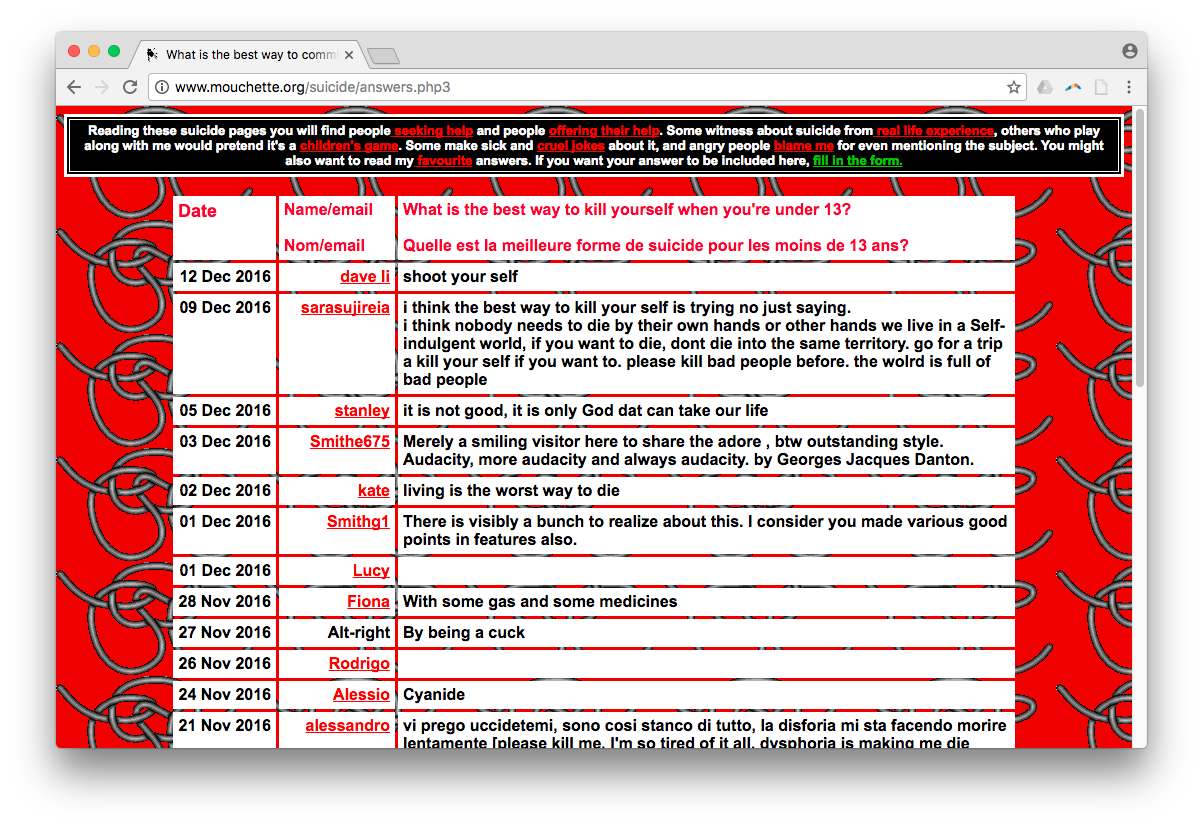
### Marseilles, 2006. An anonymous user sends an email to French law enforcement, complaining that mouchette.org has published instructions for committing suicide. Police check the registration information for the site, and arrest the technician who had most recently renewed the domain.
In France—I was hosted on a French server—a search warrant was issued that at first went straight to someone who had been my technician, who had given his address as the person responsible for the hosting. He went to jail for one night, his computer was searched.
It was a terrible moment for me because i had to find a lawyer for criminal law. When I went to the judge, she finally said no, there’s no crime, because she could read English, but I was really scared because I didn’t know what was the cause of that warrant. Actually there was nothing; through the judge I could know that there was only anonymous denunciation. Someone with an email address sent a complaint that the site was promoting suicide. And then I was issued a search warrant.
This police search did a lot of damage. A national art foundation removed their money from another artistic the project in the making as soon as they heard I was under investigation. Even when the judge sayd there’s no reason, nothing went back as it was. Being a suspect is very hard.
You can imagine, I was so surprised. I had never been careless about what I posted. At that time you had suicide groups, where people would call for suicide partners; you had sites for suicide recipes. This is forbidden in France, and I always made sure that nothing like that was posted on my site.
With suicide there are issues of free speech at several levels. In most religions, suicide is a sin. In certain cases, you may not even mention it or talk about it to children. So the problem of prevention of suicide is made really complicated, because the people who are tempted by suicide cannot seek help, because they sense this is under that ban. When they mention it, people reject the idea or the thought of it.
That’s why I got all these people coming to me. They had to vent all their anxiety that they probably couldn’t do in their normal surroundings. Today of course you have serious sites where you can vent and exchange, but at that time it didn’t exist yet.
Several pages on the site feature extreme close-ups of portions of Mouchette, creating a proximity and a surprisingly physical intimacy. [describe the work]In Flesh&Blood Mouchette sticks out her tongue as if licking the screen and asks the visitor to do the same so their tongues would meet on either sides of the screen.
Neddam: All you had was that little tiny photo, just one tiny pic of 2x2 cm or so, and then finally Mouchette presents her body. I was inspired by the fact that I just got my first scanner. So I invited a friend of mine to lay on the scanner.
The staging of the situation was really getting clearer to me—how the stage is set, let's say. The performative situation was that there was a symmetry between who was behind the screen and who was in front, and these two could meet through the surface of the glass. The glass is what allows the encounter.
Of course that glass was also the glass of the scanner, and all of a sudden the glass of the scanner would be the contact surface for the public, and would turn into the glass of the monitor.
Previously, I had been designing stage sets. I often think of the work I do as staged situations. The staged background was these pictures, and the text of the actor was this text that called for a reaction. “Want to know what my tongue tastes like? Try it on your screen and tell me.”
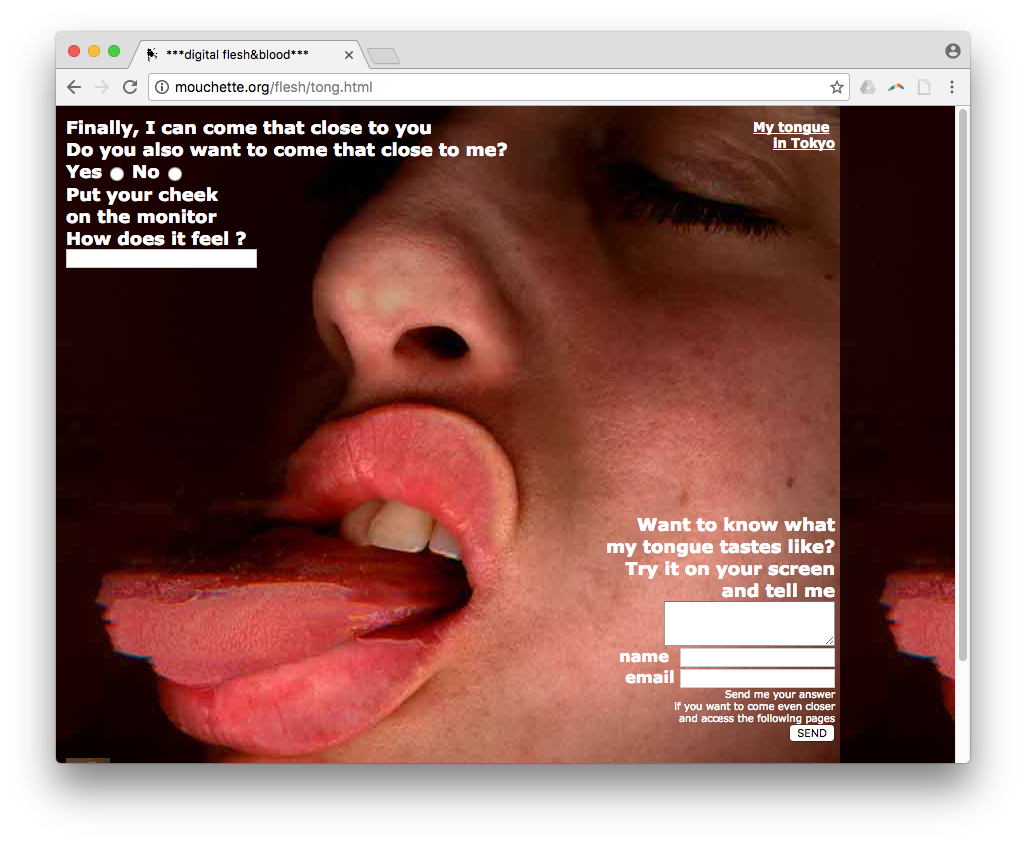
In theater, sometimes they speak of a fourth wall between actor and public, a sort of conceptual wall where they meet, but still stay separate because they don’t have the same status. That would be a similar situation, with the screen as a fourth wall, and a one on one encounter instead of a stage with actors and public.
I was also very aware of the body’s presence with the computer—your body is very present when you’re browsing things on the computer; you are physically engaged because you are at an emotional distance from the screen, at arm’s length. Everything at arm’s length enters your emotional perimeter.
That physical distance to the screen—you would never come so close [to a person as you do to the screen] unless you have an emotional relationship with them.
Along with onscreen characters and the user, the browser and the code of a work also played important roles in the staging of a work. Kill that Cat exemplifies that performative quality. The picture of a wide open cat's jaw shakes erratically while a scream goes on and on. In the middle of that mouth a shaking button says “KILL THAT CAT” and all you want is to hit that moving button and stop that scream.
Neddam: It was the sort of here-and-now of the web. You open the page and it sort of screams at you. It had that performative aspect where a crazy performer and the public meet, and something gets activated in that meeting.
The code for the shaking image is stolen from JODI. They had that shaking text and the code was easy enough to copy. I could use it with a picture of a cat's mouth looking very aggressive; the sound is a coyote, I found it online, it screams in a very ugly way. It makes for a very lively online encounter. It jumps at the screen, it shakes, it’s like experiencing a live moment of face to face with someone on the net.
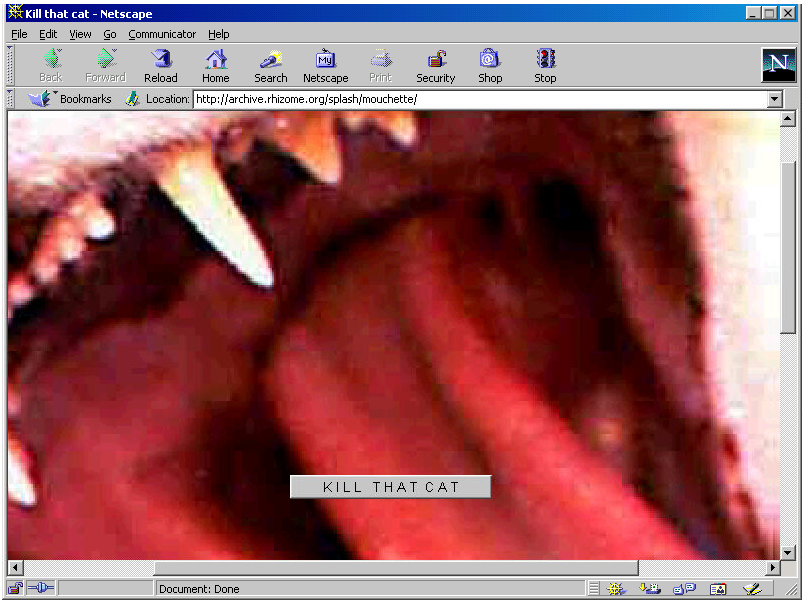
For me, the web was the ideal performance place, the performance that could go on at any time of the day. The works had that sort of here and now encounter. You know that thing was always open, twenty-four hours, it was all the time live.
When it jumps out of your screen, it comes alive. It starts screaming and jumping, and then you click it and kill it. So it has that sort of live moment, every page is live and every page dies.
I never had much pleasure in working with Flash. I only ever used it for its compatibility with sound. Flash doesn’t have that sort of live moment because it’s all in the box, whereas the HTML page seems to become alive because all of these elements have to come together in the browser. It has a live moment that a Flash equivalent doesn’t have. So when I used it it was just handy, or for compatibility reasons.
Every time you click on a link, something live happens. I still sense the web as having a sort of life, this live moment, because it can die. Only whatever can die can live.
